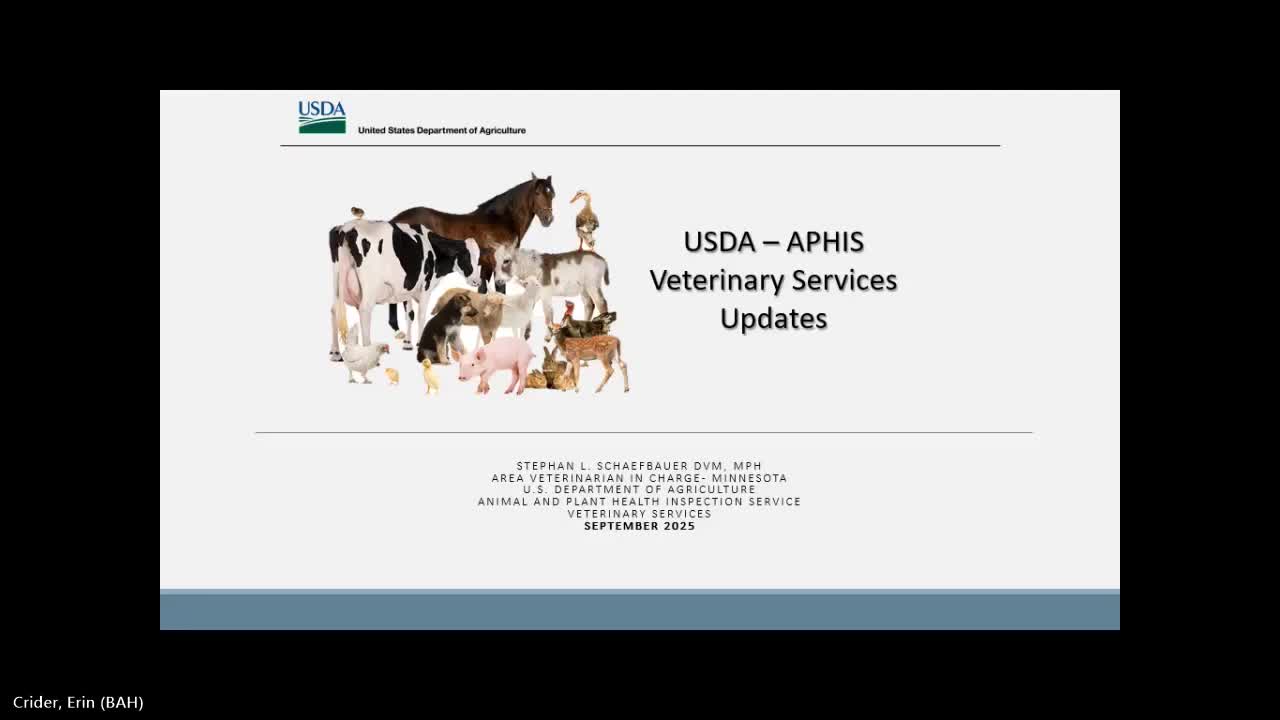USDA Implements New Biosecurity Initiatives for Poultry Amid Screw Worm Outbreak
September 11, 2025 | Board of Animal Health, Agencies, Boards, & Commissions, Executive, Minnesota
This article was created by AI summarizing key points discussed. AI makes mistakes, so for full details and context, please refer to the video of the full meeting. Please report any errors so we can fix them. Report an error »

The Minnesota Board of Animal Health convened for its Quarterly Board Meeting on September 11, 2025, focusing on critical updates regarding animal health initiatives and USDA programs. The meeting was chaired by Erica, who facilitated discussions on various topics, including poultry biosecurity assessments, USDA organizational changes, and the ongoing response to the new world screw worm outbreak.
The meeting commenced with an overview of the USDA's poultry biosecurity assessments. A representative highlighted the USDA's five-point plan aimed at strengthening biosecurity in the poultry industry, which includes a significant financial commitment of $500 million. This plan allocates funds for biosecurity improvements, financial relief for producers, and vaccine research initiatives. The representative noted that Minnesota was one of the pilot states for these assessments, which have now expanded to cover all poultry sectors. Over 1,200 biosecurity assessments have been completed nationwide, with a focus on identifying and addressing gaps in existing biosecurity plans.
Following the poultry discussion, the board addressed the USDA's recent organizational reforms aimed at streamlining operations and enhancing field presence. The USDA plans to relocate approximately 2,600 staff members to five new regional hubs across the country. Stakeholders were encouraged to participate in a public comment period regarding these changes, which has been extended until September 30, 2025.
The meeting also covered updates on the National Animal Disease Preparedness and Response Program (NADPRP). The board learned that funding for this program has increased significantly, from $18 million to $70 million annually, which will expand opportunities for projects in Minnesota and enhance emergency response capabilities.
A significant portion of the meeting was dedicated to the new world screw worm outbreak, which is currently affecting Central America and Mexico. The USDA is preparing for a domestic response, with economic impact estimates indicating potential losses in Texas alone could reach $732 million annually. The board discussed the importance of eradication efforts, which have historically yielded substantial economic benefits.
In conclusion, the meeting underscored the Minnesota Board of Animal Health's commitment to addressing animal health challenges through proactive measures and collaboration with federal agencies. The board plans to continue monitoring these initiatives and will reconvene to discuss further developments in upcoming meetings.
The meeting commenced with an overview of the USDA's poultry biosecurity assessments. A representative highlighted the USDA's five-point plan aimed at strengthening biosecurity in the poultry industry, which includes a significant financial commitment of $500 million. This plan allocates funds for biosecurity improvements, financial relief for producers, and vaccine research initiatives. The representative noted that Minnesota was one of the pilot states for these assessments, which have now expanded to cover all poultry sectors. Over 1,200 biosecurity assessments have been completed nationwide, with a focus on identifying and addressing gaps in existing biosecurity plans.
Following the poultry discussion, the board addressed the USDA's recent organizational reforms aimed at streamlining operations and enhancing field presence. The USDA plans to relocate approximately 2,600 staff members to five new regional hubs across the country. Stakeholders were encouraged to participate in a public comment period regarding these changes, which has been extended until September 30, 2025.
The meeting also covered updates on the National Animal Disease Preparedness and Response Program (NADPRP). The board learned that funding for this program has increased significantly, from $18 million to $70 million annually, which will expand opportunities for projects in Minnesota and enhance emergency response capabilities.
A significant portion of the meeting was dedicated to the new world screw worm outbreak, which is currently affecting Central America and Mexico. The USDA is preparing for a domestic response, with economic impact estimates indicating potential losses in Texas alone could reach $732 million annually. The board discussed the importance of eradication efforts, which have historically yielded substantial economic benefits.
In conclusion, the meeting underscored the Minnesota Board of Animal Health's commitment to addressing animal health challenges through proactive measures and collaboration with federal agencies. The board plans to continue monitoring these initiatives and will reconvene to discuss further developments in upcoming meetings.
View full meeting
This article is based on a recent meeting—watch the full video and explore the complete transcript for deeper insights into the discussion.
View full meeting
